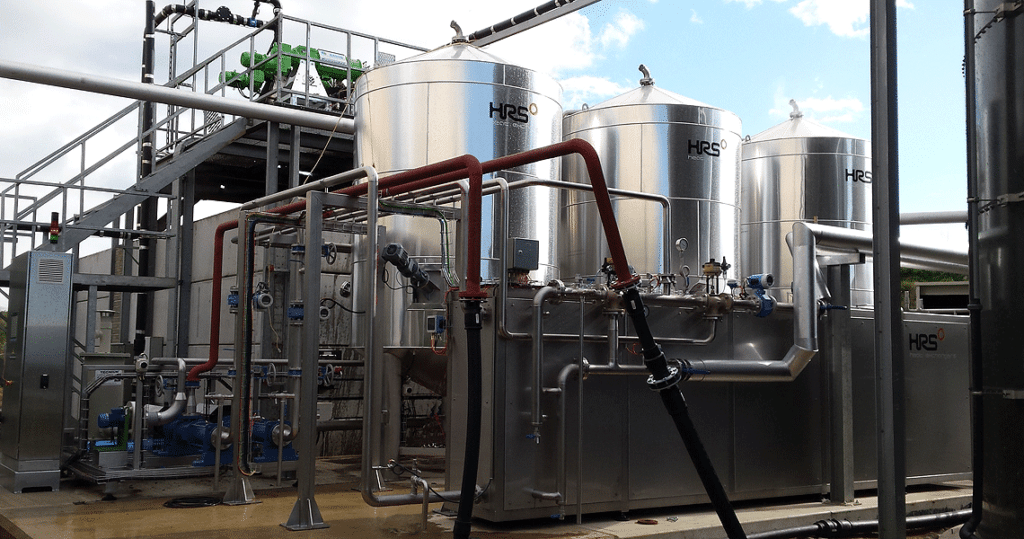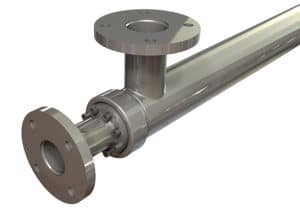Understanding Digestate

WHAT IS DIGESTATE?
Digestate is the material that remaining after the anaerobic digestion of a biodegradable feedstock such as wastewater sludge, food waste, animal waste or other organic waste products. Anaerobic Digestion (AD) produces two main products: the fibrous digestate that comprises of both solid and liquid forms, and the naturally occurring biogas that is emitted during the AD process – both of which can be re-used. When further breakdown of these separate products occurs, valuable residues can be extracted from each, making anaerobic digestion an energy-efficient and cost-effective way to produce clean and renewable energy and to recycle and reduce waste materials.

DESIGN CONSIDERATION FOR ANAEROBIC DIGESTION SYSTEMS
Waste and energy management is now high on the agenda for social and environmentally responsible processing practises. However, while AD systems can be designed to handle product processing needs and deliver excellent energy and cost saving benefits, there are other important factors to be considered during the system design process such as:
- The cost, resource and energy implications of the removal and transportation of the digestate, particularly if the plant is in a remote location or there is no local use for it.
- The use of digestate containing animal by-products.
- The pasteurisation requirements of different products for different uses.
- Compliance with local regulations when using digestate as a fertiliser.
HRS designs specialised environmental systems to incorporate any influencing factors that need to be considered alongside each plant’s processing needs, and to identify where maximum value can be gained from the three key components of waste processing systems – biogas; digestate solids; digestate liquids.
TECHNOLOGIES FOR DIGESTATE MANAGEMENT
Digestate Concentration and Evaporation

Following the production of digestate through anaerobic digestion, the resultant ‘wet’ digestant product can be separated into solid and liquid states and further concentrated. The concentration of the solid state digestate produces a more compact and nutrient-dense product, while the evaporation of the liquid state digestate can reduce its volume by up to 80% producing both a valuable nutrient-concentrated liquid and a condensate that can be re-used elsewhere in the AD plant, such as for the dilution of feedstock going into the front end of the digester. The HRS DCS system has been designed to be a closed loop, self-sufficient system that negates the need for additional water or energy as all elements are used and no waste is created.
The high temperatures needed to concentrate digestate can cause the release of ammonia, largely responsible for the odours associated with digestate. The DCS overcomes this by acid-dosing the digestate with sulphuric acid which decreases the pH levels, turning the ammonia into ammonium sulphate, which is not only less odorous, but is also an ideal biofertiliser.
While the volume of digestate is reduced, the nutrient content is not merely locked in after concentration – it increases.
Digestate evaporation is an economically viable option for AD plants as higher quality useable commodities are produced, the costs of transport and waste removal are minimised, and gains in energy efficiency, environmental responsibility and brand reputation are made.
Learn more HRS DCS (Digestate Concentration System).
Digestate Pasteurisation

To use digestate as land fertiliser, it needs to be free from dangerous chemicals and harmful agents such as pathogens. Pasteurisation of the digestate is required, with the process time and temperature requirements defined and dictated by in-country regulations relating to product use. Pasteurisation is a thermal process. Waste heat is used to heat up the digestate and insulated tanks are used to hold the digestate at the pasteurisation temperature for as long as is required.
The HRS DPS (Digestate Pasteurisation System) employs energy recovery and is typically two to three times more efficient than traditional systems. The HRS DPS transfers energy from the hotter (pasteurised) sludge to the colder (unpasteurised) sludge, reducing energy consumption by up to 70 per cent and maximising heat which would have otherwise been wasted. This also circumvents the need to install an additional heat source such as a biomass boiler, which could add hundreds of thousands of pounds to a project. Additionally, the DPS can be used alongside macerators to decrease and control the maximum dimension of solid particles contained within the digestate.
The HRS DPS has been designed with corrugated instead of smooth tubes because that corrugation has in boosting heat transfer by creating extra turbulence. Not only does this reduce fouling as the digestate is less likely to stick to the tube walls, but there is a significant reduction in downtime and maintenance requirements and an increase in the system’s overall lifespan.
Watch our short video on the Sludge Pasteurisation Process for more information.
ENERGY EFFICIENCY
The AD process relies on providing constant heat to the digester, however the level of energy needed for this is often less than the total energy emitted from the system’s CHP (combined heat and power) units. By capturing the excess energy, it can be used to drive other thermal processes in the AD plant such as digestate evaporation and pasteurisation. CHP heat is available in two forms: engine cooling water (typically 90-70 ºC water) and exhaust gas (exits between 450-500 ºC).
Should the total amount of CHP be insufficient to provide for all processes, other thermal energy sources will be required such as steam or water boilers, which can be run with biomass, natural gas or other. Deciding how and which energy source should be used for what process within an AD system, will depend on several factors.

HRS designs optimal heat transfer processes for the AD systems using the following heat transfer technologies:
HRS DTI SERIES HEAT EXCHANGERS

HRS DTI Series heat exchangers are designed for all digestate and sludge applications. The tube in tube heat exchanger has a corrugated inner tube to deliver a much higher rate of heat transfer compared to smooth tube heat exchangers due to the extra level of turbulence generated. The high rate of turbulence significantly reduces the effects of fouling on the heat transfer surface and so extends the system’s run time. The large diameter inner tube makes easy work of processing digestate products containing fibres or large particles, and the DTI product has been designed to make cleaning and maintenance far easier than traditional spiral heat exchangers.
Read more about the HRS DTI Series.
HRS DTIR SERIES HEAT EXCHANGERS

The HRS DTIR Series is an adaptation of the HRS DTI Series of heat exchanger. Both DTI and DTIR are constructed as tube in tube heat exchangers that incorporate a large diameter inner tube with a corrugation profile, however the DTIR Series has been specifically designed for direct product to product heat recovery, where heat emitted from hot digestate can be transferred to cold digestate inside the heat exchanger. Additionally, inspection and cleaning the shell side channel is made easy due to the removable inner tube of the DTIR heat exchanger.
Read more about the HRS DTIR Series.
HRS G SERIES HEAT EXCHANGERS

The HRS G Series Heat Exchanger is a complete stainless steel multitube heat exchanger designed specifically for exhaust gas cooling and thermal recovery applications. Cooling and recovering the heat from exhaust gases can increase the efficiency of CHP units and be used in other plant processes such as feedstock and digester heating, pasteurisation and digestate concentration. The G Series is a compact system that uses corrugation technology to enhance heat transfer rates and recover energy.
Read more about the HRS G Series.
HRS SCRAPED SURFACE HEAT EXCHANGERS

The HRS Scraped Surface Heat Exchanger Series are designed to handle the toughest challenges for heat transfer applications, namely heat exchanger fouling and the processing of high viscous fluids. In AD processing, both issues are commonplace resulting from the fouling-rich content of the digestate itself, and the evaporation/concentration processes used in its production. The mechanical movement of scraped surface heat exchangers, such as the patented HRS Unicus Series which reciprocates and the HRS R Series which rotates, keeps heat transfer high and heat exchanger surfaces clean.
Read more about the Scraped Surface heat exchangers HRS R Series and Unicus Series.
THE BENEFITS OF AN OPTIMISED AD SYSTEM
Energy efficiency, footprint reduction and scalability are fundamental to all HRS AD system designs. With the right system in place, they can deliver the following benefits:
- Rich in nitrogen, phosphorus, and potassium, digestate can produce a natural high-nutrient, and odourless fertiliser that will help raise soil organic matter levels and increase water holding capacity. HRS AD systems are designed to produce a superior quality digestate that is less expensive and more environmentally friendly than chemically produced fertilisers.
- Regulation-compliant pasteurisation treatments ensure harmful substances and pathogens are eliminated from digestate fertilisers, making them suitable for land spreading purposes.
- Concentration significantly reduces the volume of digestate. This means that, whether your digestate creates a commodity that can be used or sold, reducing its volume will decrease the expense of storage, transport, application, and disposal.
- Appropriate thermal energy sources and heat transfer operations can optimise heat recovery and save as much as 70% of the thermal energy needed for processes such as evaporation and pasteurisation.
- By-products can be converted to an additional revenue stream and source of income.
Read the case study to see how a production plant fitted with digestate processing compares to a plant without it, and the return on investment projections.